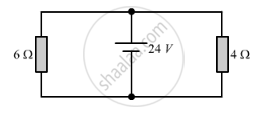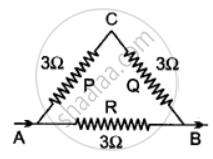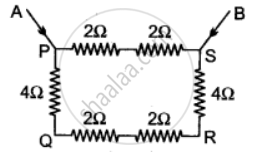Advertisements
Advertisements
प्रश्न
Find the current in each resistor in the circuit shown below:

उत्तर
In the given circuit, two 6 Ω and 4 Ω resistors are connected in parallel combination across a cell of 24 V. We know that in a parallel combination, the voltage across the resistor remains the same and only the current gets divided. So the current (I1) through the 6 Ω resistor is:
`I_1=V/R_1`
here R_1=6Ω
V=24V
so
`I_1=24/6`
`or I_1=4A
`The current (l_2) through the 4 resistors is :`
`I_2=V/R_2`
R_2=4Ω
`I=24/4`
`or I=6A`
APPEARS IN
संबंधित प्रश्न
A hot plate of an electric oven connected to a 220 V line has two resistance coils A and B, each of 24 Ω resistances, which may be used separately, in series, or in parallel. What are the currents in the three cases?
You are given three resistances of 1, 2 and 3 ohms. Shows by diagrams, how with the help of these resistances you can get:
(i) 6 Ω
(ii) `6/1` Ω
(iii) 1.5 Ω
How will you connect three resistors of 2 Ω, 3 Ω and 5 Ω respectively so as to obtain a resultant of 2.5 Ω? Draw the diagram to show the arrangement.
What are the advantages of a parallel connection?
How does the resistance of a metallic wire depend on the length of wire?
Calculate equivalent resistance in the following cases:


Two resistors when connected in parallel give the resultant resistance of 2 ohms, but when connected in series the effective resistance becomes 9 ohms. Calculate the value of each resistance.
A piece of wire of resistance R is cut into three equal parts. These parts are then connected in parallel. If the equivalent resistance of this parallel combination is R1, what is the value of the ratio R1 : R?
Two resistors having resistance 8 Ω and 12 Ω are connected in parallel. Find their equivalent resistance.
Two resistors of resistances 2 Ω and 3 Ω are connected in parallel to a cell to draw current 0.5 A from the cell. Draw a labelled diagram of the arrangement
